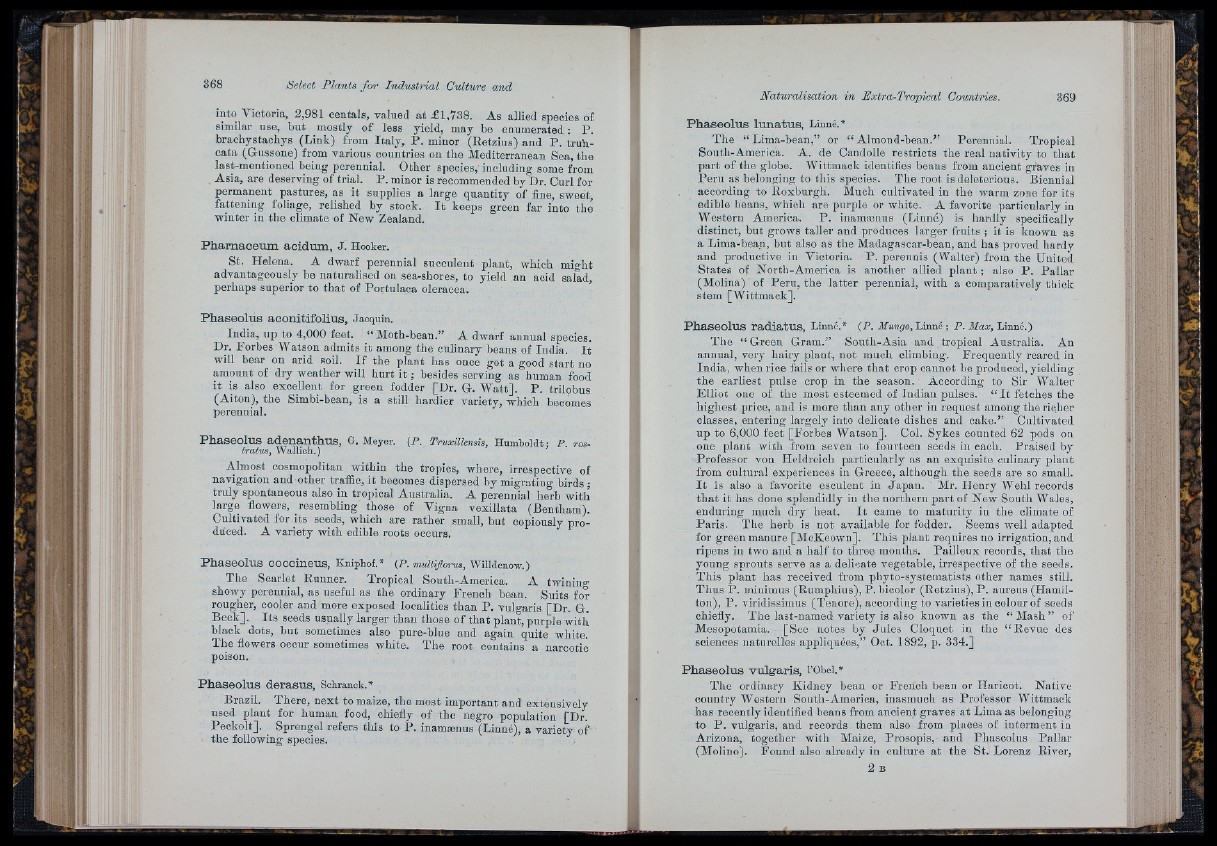
L
î,. ■
'i |:
... f :
lii
ifr’i;.- I'.
Lui'i
ï - j]
into Victoria, 2,981 centals, valued a t £1,738. As allied species of
similar use, but mostly o f less yield, may be enumerated : P.
brachystacbys (Link) from Italy, P . minor (Eetzius) and P . truncata
(Gussone) from various countries on the Mediterranean Sea, the
last-mentioned being perennial. Other species,’including some from
Asia, are deserving of trial. P. minor is reoommended by Dr. Curl for
permanent pastures, as it supplies a large quantity of fine, sweet,
fattening foliage, relished by stock. I t keeps green far into the
winter in the climate of New Zealand.
Pharnacetun acidum, J . Hooker.
St. Helena. A dwarf perennial sucoulent plant, which might
advantageously be naturalised on sea-shores, to yield an acid salad,
perhaps superior to th a t of Portulaca oleraoea.
Phaseolus aoonitifolius, Jacquin.
India, up to 4,000 feet. “ Moth-bean.” A dwarf annual species.
Dr. Forbes Watson admits it among the culinary beans of India. I t
will bear on arid soil. I f the plant has once got a good sta rt no
amount of dry weather will hurt it ; besides serving as human food
it is also excellent for green fodder [Dr. G. W a tt]. P. trilpbus
(Aiton), the Simbi-bean, is a still hardier variety, which becomes
perennial.
Phaseolus adenanthus, G, Meyer.
tratus, Wallich.)
(P. Truxillensis, Humboldt; P. ros-
Almost cosmopolitan within the tropics, where, irrespective of
navigation aud other traffic, it becomes dispersed by migrating birds ;
truly spontaneous also in tropical Australia. A perennial herb with
iarge flowers, resembling those of Vigna vexillata (Bentham).
Cultivated for its seeds, which are rather small, but copiously produced.
A variety with edible roots occurs.
Phaseolus cocoineus, Kniphof.* {P. muUiflorus, Willdenow.)
The Scarlet Runner. Tropical South-America. A twining
showy perennial, as useful as the ordinary French bean. Suits for
rougher, cooler and more exposed localities than P. vulgaris [Dr. G.
Beck]. I ts seeds usually larger than those of th a t plant, purple with
black dots, but sometimes also pure-blue and again quite white.
The flowers occur sometimes white. The root contains a narcotic
poison.
Phaseolus derasus, Sohranok.*
Brazil. There, next to maize, the most important and extensively
nsed plant for human food, chiefly of the negro population [Dr.
Peckolt]. ^ Sprengel refers this to P. inamænus (Linné), a variety of
the following species.
Phaseolus lunatus, Linné.»
The “ Lima-bean,” or “ Almond-bean.” Perennial. Tropical
South-America. A. de Candolle restricts the real nativity to that
part of the globe. Wittmack identifies beans from ancient graves in
Peru as belonging to this species. The root is deleterious. Biennial
according to Roxburgh. Much cultivated in the warm zone for its
edible beans, which are purple or white. A favorite particularly in
Western America. P. inamænus (Linné) is hardly specifically
distinct, but grows taller and produces larger fruits ; it is known as
a Lima-bean, but also as the Madagascar-bean, and has proved hardy
and productive in Victoria. P. perennis (Walter) from the United
States of Nortli-America is another allied plant ; also P. Pallar
(Molina) of Peru, the latter perennial, with a comparatively thick
stem [Wittmack].
Phaseolus radiatus, Linné.» (P. Mungo,ÏAnné; P. Max, Linné.)
The “ Green Gram.” South-Asia and tropical Australia. An
annual, very hairy plant, not much climbing. Frequently reared in
India, when rice fails or where th a t crop cannot be produced, yielding
the earliest pulse crop in the season. According to Sir Walter
Elliot one of the most esteemed of Indian pulses. “ I t fetches the
highest price, and is more than any other in request among the richer
classes, entering largely into delicate dishes and cake.” Cultivated
up to 6,000 feet [Forbes Watson]. Col. Sykes counted 62 pods on
one plant with from seven to fourteen seeds in each. Praised by
Professor von Heldreich partioularly as an exquisite culinary plant
from cultural experiences in Greece, although the seeds are so sm.all.
I t is also a favorite esculent in Japan. Mr. Henry Wehl records
th a t it has done splendidly in the northern part of New South Wales,
enduring much dry heat. I t came to maturity in the climate of
Paris. The herb is not available for fodder. Seems well adapted
for green manure [McKeown]. This plant requires no irrigation, and
ripens iu two and a half to three months. Pailleux records, that the
young sprouts serve as a delicate vegetable, irrespective of the seeds.
This plant has received from pliyto-systematists other names still.
Thus P. minimus (Rumphius), P. bicolor (Eetzius), P . aureus (Hamilton),
P. viridissimus (Tenore), according to varieties in colour of seeds
chiefly. The last-named variety is also known as the “ M a sh ” of
Mesopotamia. [See notes by Jules Cloquet in the “ Revue des
sciences naturelles appliquées,” Oct. 1892, p. 334.]
Phaseolus vulgaris, rObel.*
The ordinary Kidney bean or French bean or Haricot. Native
country Western South-America, inasmuch as Professor Wittmack
has recently identified beans from ancient graves at Lima as belonging
to P . vulgaris, and records them also from places of interment in
Arizona, together with Maize, Prosopis,. and Phaseolus Pallar
(Molino). Found also already in culture at the St. Lorenz River,